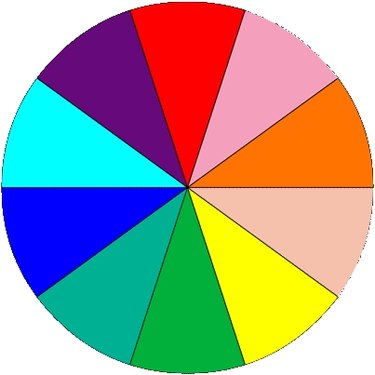
Your daughter has married and relocated across country. She no longer lays claim to her bedroom that has remained untouched since she graduated from high school eight years ago. You decide to revamp the bedroom and use it as your guest room. You’ve painted the walls teal but are stumped when it comes to picking the right colors for accessories and accents. Consider using complementary colors.
Step 1
Realize that teal, or blue-green, is a tertiary color, which means it’s comprised of equal mixes of a primary color (blue) plus its closest secondary color (blue-green). Look at a color wheel, which can be purchased in most home improvement stores.
Video of the Day
Step 2
Learn that the complementary color for teal (blue-green) is red-orange, also a secondary color.
Step 3
Consider if two such bold colors as teal and red-orange would be overwhelming. If so, use very little of the red-orange. Put a splash here, in a flower arrangement, and a splash there, a throw pillow, but leave it at that.
Step 4
Decide what colors with which you’re most comfortable. If the bold contrast of red-orange and teal doesn’t appeal to you, stick with harmonious colors, which would be the colors that lie to the right and to the left of blue-green on the color wheel, such as grass green, royal blue or even yellow-green or blue-violet.
Step 5
Crank it down a notch by using variations of red-orange which include a salmon-colored “tint” (the result of red-orange mixed with white) or a “tone” of the red-orange, which is a taupe color and achieved through adding gray to the red-orange, or a darker, less bright “shade” of red-orange, almost a rust color, which is achieved by adding black to the red-orange. These colors can all be used as complements to your teal guest room and are much more subtle than the startling red-orange color.
Step 6
Think about adding some white to the teal paint that was used on the walls. The result will be a restrained and less vibrant shade of blue-green, which can be used with all of the above colors as an accent color. Paint a chair or picture frame using this cool, soothing shade.
Step 7
Consider adding some black to the teal paint. This will give you a deeper shade of blue-green and would be ideal color for accent pieces.
Step 8
Toss in some white or other neutral colors. White curtains can look great against a teal wall. White or ivory woodwork also create a nice contrast.
Tip
Buy a color wheel. Learning about colors is fun and interesting. You might discover that colors that you never dreamt of combining look great together.
Video of the Day